01/23/2018
Travel Blog: Wolf Fellows Israel Mission
- Share This Story
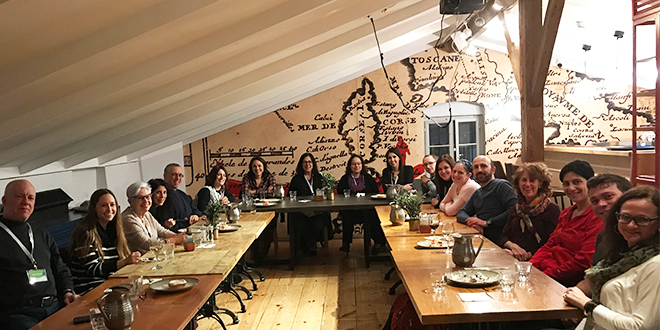
Shalom from Israel! Seventeen Federation staff members are on the Wolf Fellows Israel Seminar, experiencing all that Israel has to offer. Read about their experience now:
January 22, 2018
by Barry Reis
Our Wolf Fellows journey began today with a visit to the spot where Tel Aviv was established, as our first stop after the majority of the group arrived at the airport. Our guide, Abraham Silver, took us to the place where 60 Jewish families left Jaffa in 1909 to pursue a dream of a uniquely Jewish city, in a place that only featured sand dunes. Through hard labor and an attitude that one should work hard to make dreams come true, rather than change those dreams, they built a city from nothing. They started with a cemetery, then the first Jewish school in 2,000 years, then hospitals, businesses, theaters, opera, police, fire and a library. From those original 60 families, the city grew to 30,000 by 1930, 160,000 by 1940, and 3.5 million today, most of whom are Jewish. So, unlike Jerusalem, which is central to so many religions, Tel Aviv today is the most Jewish city in the world.
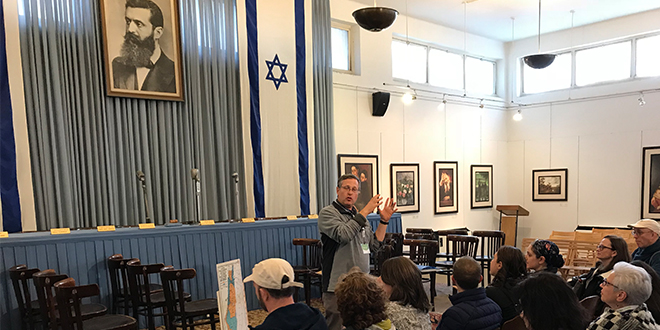
We later went to Independence Hall, where we learned about the drafting and signing of the Declaration of Independence. We learned that the word "G-d" is not mentioned in it, as the signers needed to find a compromise between reference to religion vs. Jewish identity, choosing "Rock of Israel" as that compromise.
We then talked about who the founding families were. Most Jews in the late 1800's lived in ghettos and their choices were generally to assimilate or stay in the ghettos. Zionism was a movement whereby Jews could "go home to be modern and Jewish." This pulled many Jews to come to Israel. Other Jews were pushed here as a result of anti-Semitism. The Kishniev pogrom in 1905 was a defining event, which Bialik wrote a poem about – the reticence of the men in Kishniev to fight back because religious leadership discouraged it caused many to leave for a modern Jewish homeland. Tel Aviv, unlike places in the diaspora like New York, would be a place where Jews would be safe from anti-Semites. Rather than religion being the glue to Judaism, the land of Israel, Jewish defense, and culture would now serve in that role. The Hebrew language replaced Yiddish as the native tongue. Everything about Tel Aviv was Jewish – you will not find any churches in the city. "Jewish" became a national identity.
We began to discuss the challenges the country faces today, given the Declaration's commitment to welcomeness and equality. This was put in context with today's action in the Knesset to handle Arab protesters at U.S. Vice President Mike Pence's appearance.
We have a lot to learn and discuss this week....
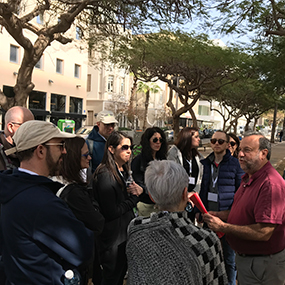
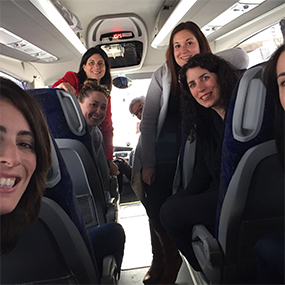
January 23, 2018
by Kari Blumenthal and Carol Wolf
Shalom! Day 2 began with a huge breakfast buffet at the hotel. You will notice that eating is a central theme of our trip! Then we headed out through the wind and rain to our first stop – a Jewish Agency for Israel (JAFI) absorption center. Federation partners with JAFI on many programs including Youth Futures and Masa Israel. We had the privilege of speaking with Alan Hoffmann (no relation to Steve) who is the CEO and Director General of JAFI. He spoke about the core values and goals of the agency which include: Aliyah and absorption, connecting Jews to Israel, connecting Israelis to Jewish people, and supporting vulnerable populations. JAFI has brought over 4 million people to Israel. They help over 60,000 people making Aliyah to Israel each year.
We then had the chance to speak with several of JAFI’s program participants and hear their stories and their reasons for making Aliyah. They seem to follow a theme we continue to hear about Israelis – Israelis don’t think, they do. Many of these participants knew they wanted to come to Israel and while some would overthink such a drastic move, these young adults acted on their dreams and came to Israel.
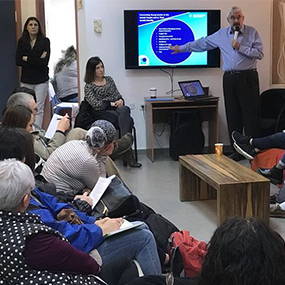
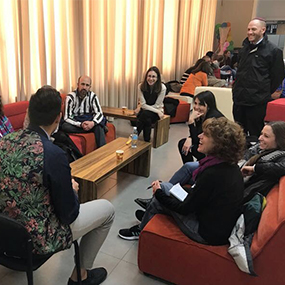
Since we hadn’t eaten in about four hours, we went to the port for our standard three-course lunch. We were joined by two young Clevelanders who are participating in the Masa Israel program. Since the rain curbed our original plan of a walking tour of the port, we headed back to the hotel to learn more about the port from Hartman Institute Scholar, Rani Jaeger. Rani is also a founder of Beit Tefilah Yisraeli – a program that has brought Kabbalat Shabbat to the port for the past decade. During the summer months, about a thousand Israelis of all denominations attend these Friday night celebrations.
We finished the evening with dinner in the Florentine neighborhood with more Cleveland students. Oren then gave us a walking tour of the neighborhood before heading back to the hotel. We are learning, laughing, and eating our way through Israel.
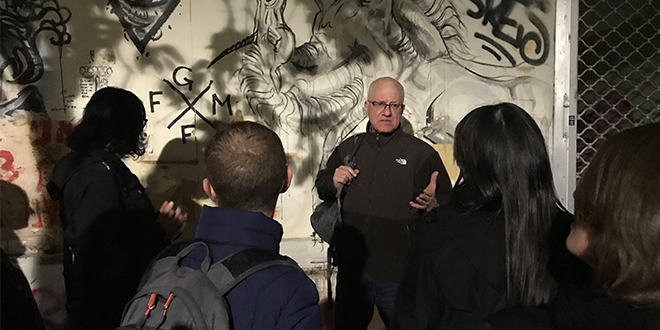
January 24, 2018
by Lisa Hacker
"A Mosaic of Israeli Society" was the program’s theme on Wednesday. Following a delicious breakfast, we departed for the Arab town of Tira. We spent the morning with Dahlia Fadila, the dean of the technical college associated with the El Qasame Islamic College in Baqa el Garbiya. She is also the founder and director of the Q School. Ten years ago, Dahlia had a dream: To create change in an Arabic speaking community by learning and embracing English and Hebrew languages. Today, over 3,000 children attend the Q School! In more recent years, Dahlia created the Arab Youth Leadership Center to engage and empower young women in her community.
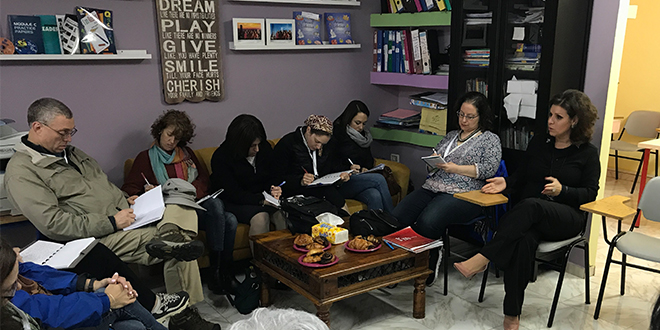
We then departed for the Havat Hashomer army base near Kfar Tabor to see firsthand the many ways the IDF gives youth at risk a second chance. LTC Samuel Boumendil provided a history and overview of the base over lunch in their cafeteria. This dining hall is filled with photos and inspirational quotes to positively change the mindset and personal growth of its soldiers. Most notably, Havat Hashomer is led by female commanders in an effort to minimize instances of violence and nurture the I can do anything mindset. It was truly moving.
The remainder of the day was spent with our partnership region, Beit Shean/Valley of Springs. We were graciously welcomed by Dorit Natan-Levy, Director of Partnership2Gether (Cleveland/Beit Shean partnership), and her team, learned about the challenges this peripheral area faces, and the many ways the Jewish Federation of Cleveland’s projects offer support. Visits like this one illustrate the incredible connections and partnerships between our communities and only strengthens our personal relationships. The evening concluded with a festive Kurdish dinner, costumes and dancing, and an interactive dialogue with our counterpart colleagues. We spent the evening on a quaint kibbutz at the Nir David Country Lodge.
L'hitraot! (See you soon!)
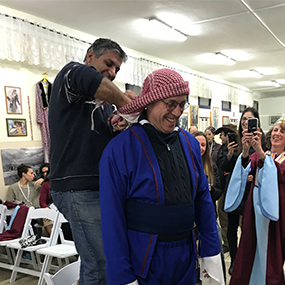
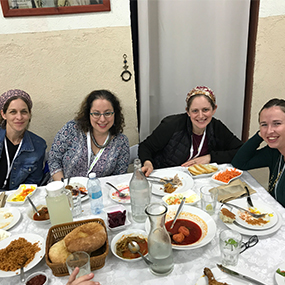
January 25, 2018
by Susan Hyman and Ellen Miller
Following a peaceful overnight at Kibbutz Nir David we were off to a full day of learning about our partnership programs at our sister city of Beit Shean. The on-again/off-again rain didn't put a damper on our spirits, as we were all excited to see how our Federation funded programs have made a difference in the Beit Shean community.
At our first stop, we paired up with middle school students involved in Youth Futures, a program for children at-risk. This phenomenal after school program engages a total of 12,000 students and their families in 35 communities across Israel using a holistic approach to increase self-esteem, grades, and interpersonal relationships under the guidance of 400 mentors. Although not all of children spoke English, we communicated through art by creating our favorite foods using play dough. Hands-down, the majority of children liked burgers and chips (french fries) and pizza.
Next we toured Idan Technology, a flagship program that serves Beit Shean, the Valley of Springs students, and the community. Students from the area are bussed to this state-of-the-art building for 2-hours a week where they are engaged in all forms of technology, from laser machinery to robotics to electrical and mechanical engineering. Quite impressive!
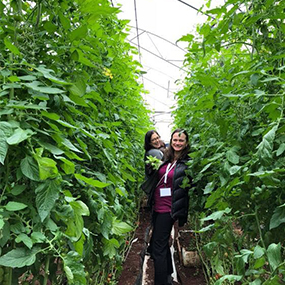
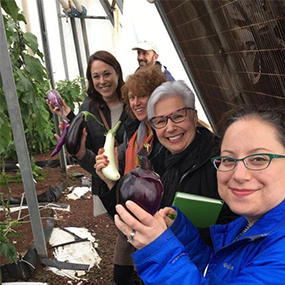
Half of our group then met up with our friend Zion Dako, the director of Eden Farm. Many of us know Zion from his visits to Cleveland when he shared his research with urban farmers and planners. We were quite a sight, trudging through the muck and mud to see the greenhouses, but it was worth it to see the colorful and delicious fruits and vegetables that we got to taste on the tour. The farm continues to research red-Palm weevil greenhouse solutions and has an ongoing relationship with farmers in Jordan. A very modest man, Zion expressed pride in this cross-border initiative.
Efi took the other half of the group to Beit Shean National Park. We were able to see the ancient walls that surrounded the city, public baths, a Roman Temple, stores, and the amphitheater. One of our colleague's from Youth Futures had her wedding at the park and she showed us where her chuppah had been. Efi sharing his personal stories and family connections made this awesome place even more amazing!
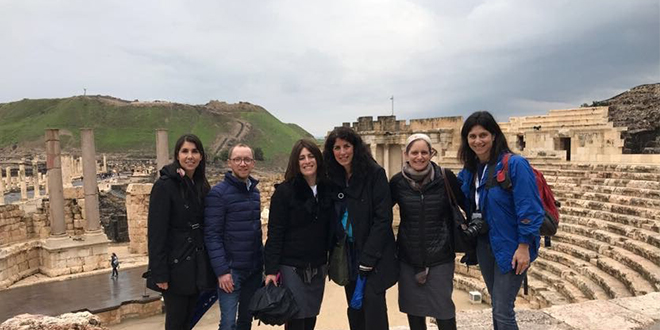
By now we had worked up quite an appetite and were treated to a Moroccan lunch at the home of one of the "Cooks of the Region" Lily Twizer. Through guidance and training from Bridge to the Future, Lily learned how to turn her culinary skills into a thriving business where she serves delicious meals to tourists visiting the region.
Ido and Meirav from Bridge to the Future took us to see the new train station which goes from Beit Shean to Haifa in 50 minutes. They explained that this opened up opportunities in the job market to people living in the periphery, and that this would really benefit the area and hopefully encourage young people to move there. We also stopped to see a community garden which was created to help the residents feel a sense of pride and ownership by helping beautify their neighborhoods and keep them clean.
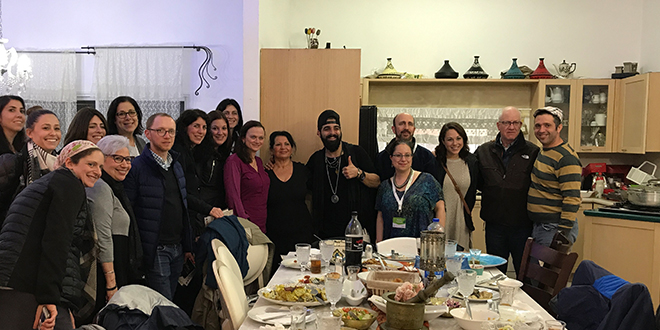
January 26, 2018
by Leora Lanzola
Our first full day in Jerusalem was met with a beautiful sunrise over the Jerusalem hills. The theme for our day on Friday was “Memories and Future in Israeli Society.” We began the day by meeting Shlomo Balsam, who currently works at Yad Vashem, Israel’s Holocaust Memorial. Shlomo was born in Paris in 1948 and moved to Israel in 1968. During World War II, Shlomo’s father fought in the French Resistance. In 1936, his mother moved to Palestine and in 1942, she joined the British Army to help in the fight against Nazi Germany. One important point Shlomo shared was that it was despite the Holocaust, not because of it, that we have a Jewish State in Israel. People were fighting for a Jewish State prior to and during the Holocaust.
Shlomo told us a story about when he was a young boy and he found a shoe box of old photos. One photo showed his aunt and cousins in Paris during World War II, wearing yellow stars identifying them as Jews. Soon after the photo was taken, they were sent to Auschwitz where they perished.
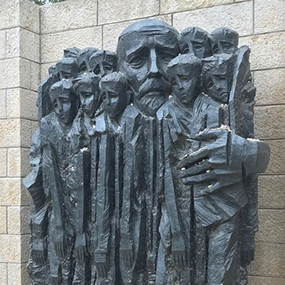
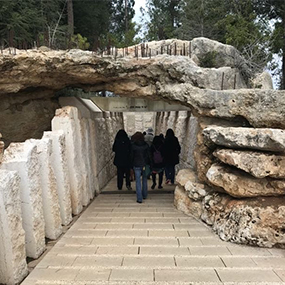
Shlomo shared that he was named after his cousin, a very young boy in the photo. And while his mother wanted him to be a lawyer or doctor, and his father wanted him to be a handyman with a vocational profession, Shlomo decided to become an educator. He told us that since photos can’t speak for themselves, he committed to speaking for them, and decided that the best resistance and revenge is education and to never let the stories of those who both perished and survived the Holocaust be forgotten. (And also, to make Jewish babies.)
Shlomo also shared with us his most meaningful experience as a tour guide in Yad Vashem. He told us about a group he had led who were survivors of the genocide in Rwanda. When he asked them why they traveled to Israel to see Yad Vashem they shared that they came “to learn how to remember” from the Jewish people who truly know how to remember the past. Years later, he was still in touch with the group who shared that they had returned home and built their own memorial and museum. They told Shlomo that the first room in the new museum was dedicated to the Holocaust and the second to the Genocide in Uganda to show a universal picture and illustrate how the world was silent during both periods in history.
Shlomo left us with thoughts and questions about the anti-Semitism that existed in France prior and during World War II and the parallels we are seeing today.
Next, we departed for Yad Vashem and had a guided tour of the museum. Many of us had visited the museum before, but each time is a new experience. We learned about the communities that were devastated during the Holocaust, but also about the heroes, both Jewish and not, that did everything they could to save people’s lives and faith during this period of destruction. We also learned about the very personal family connections and stories within our group as they relate to our history. We walked through the children’s memorial and concluded our visit with Kaddish— the mourner’s prayer— in memory of the 6 million mothers and fathers, sons and daughters, brothers and sisters, aunts and uncles, cousins and friends that lost their lives during the Shoah.
As we departed with heavy hearts, the beautiful views of Jerusalem helped us prepare to enter into our Shabbat in one of the most spiritual cities in the world. Shabbat Shalom from Jerusalem!
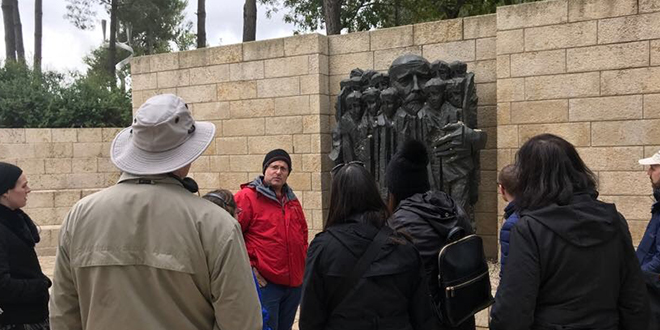
January 27, 2018
by Jessie Bruder and Dan Strom
Shabbat Shalom!
As the sunset over Jerusalem, we were looking forward to our first Shabbat in Israel since our trip began. Through a program named “Shabbat of a Lifetime,” we were invited into the home of Rina and Rabbi Manny Quint where we shared an unforgettable Shabbos meal with other Jewish and non-Jewish groups from all over the world including as far away as Singapore! Manny and Rina led the group during the prayers and took the time to ensure that all participants understood the meaning and importance behind the Shabbat dinner. Following the amazing dinner, Rina shared her personal story of surviving the Holocaust of which she has also documented in her book, "A Daughter of Many Mothers: Her Horrific Childhood and Wonderful Life." Rina inspired us all with her story of perseverance, her contagious spirit, and overall joy for life. It was a very special evening!
We didn’t let the rain and cold deter our group from experiencing many different areas of Israel on Saturday. Some went to visit family, some stayed in Jerusalem, and two members of the group spent the day touring the top of Masada followed by a visit to the Dead Sea. The visit to Masada was made even more special with the ‘Cleveland-esque’ rain and cold weather. We were told that rainfall at Masada is a very rare occurrence, so I guess we should consider ourselves lucky. Unfortunately, the weather made it difficult to fully enjoy the Dead Sea for too long. However, we did have the opportunity to step foot into the sea and enjoy the amazing scenery.
For those who stayed in Jerusalem, we started our day with a happy reunion with past Cleveland Shlicha (Israeli emissary), Clil Gross, who now lives about an hour from Jerusalem. Over a yummy Israeli breakfast, we had the opportunity to catch up and look at pictures of Clil’s beautiful family. We then spent the day exploring Jerusalem’s Israel Museum. The Israel Museum is the largest cultural institution in Israel, which houses a collection of works dating from prehistory to present day in archaeology, fine art, and Jewish art and life. Since opening in 1965, the museum continues to grow and expand and contains permanent exhibits, a dynamic children’s museum, a beautiful Art Garden, the Shrine of the Book (home to the 2,000 year old Dead Sea Scrolls), and temporary exhibits (including moving exhibits from Ai WeiWei: Maybe, Maybe Not addressing human rights and freedom of expression and Zoya Cherkassky: Pravda, an exhibit of realist paintings highlighting the massive Russian immigration to Israel in the 1990s). Many of us found the museum to be fascinating, from the people-watching of tourists from all over the world and young families from Israel to the captivating exhibits.
We enjoyed a relaxing lunch and afternoon at Jerusalem’s Tachana, a restored train station that has been transformed into a center for arts, culture, and food. After bringing in the new week together and reflecting upon our unique Shabbat experiences, we spent the evening exploring Machane Yehuda, Jerusalem’s open air market famous for its 250 vendors selling fresh produce, falafel, spices, textiles, Judaica, baked goods, and a group favorite, Marzipan chocolate rugelach. The surrounding streets near Machane Yehuda boast many restaurants from some of Israel’s most famous chefs. At night, Machane Yehuda transforms from a busy market into a lively gathering place to enjoy drinks, socializing, and music. Many of the vendors remain open while others close their metal shutters, but contribute to the lively atmosphere of the market as they have allowed local street artist, Solomon Souza, to transform their doors into portraits of many well known Israeli icons. The energy from Jerusalem, and the Shabbas naps, rejuvenated our group for our next week in Israel.
Shavua Tov! To a good week!
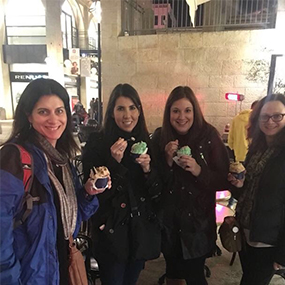
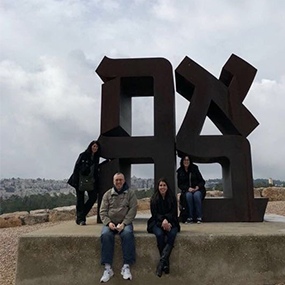
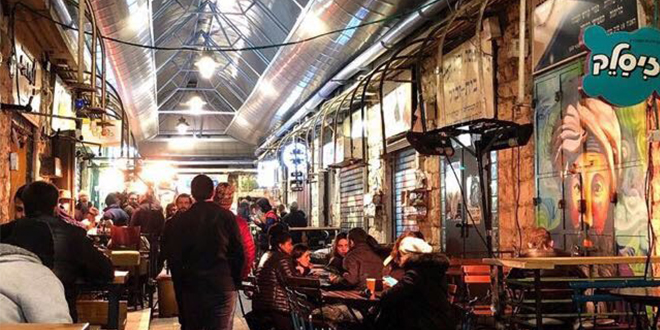
January 28, 2018
by Naomi Fein and Allen Roth
Today was a very heavy day where we talked about the conflicting narratives of Jerusalem and surrounding area; whether this is called "Judea - Samaria" or the "West Bank" or "Occupied Territories" is a personal political statement. The guests we met with today, spanned the political spectrum starting with the political left and progressing to the political right. Our day culminated in a dinner with MK Nachman Shai from the central left Labor party.
We started the morning meeting with Danny Seidemann, a practicing attorney in Jerusalem specializing in legal and public issues in East Jerusalem, and one of the founders of the NGO Terrestrial Jerusalem. He gave us his geopolitical overview of Jerusalem. Danny began with sharing the historical context for the current situation. We stopped on Route 1 that separates East and West Jerusalem, built on the Jordanian border prior to 1967. We moved on to a ridge next to French Hill, where we could see the separation wall, an area with high rise apartment buildings considered a refugee camp, a small Bedouin village, and an East Jerusalem Palestinian community. While hearing the details of each of these communities, we were joined by a flock of sheep and their young Bedouin Shepherd. During this visit, we heard a number of issues that have developed having all of these communities in such close proximity, such as the addition of the light rail and the silent protests that exist today.
We then drove down to Merkaz Karama, or the Dignity Center. This is home to two movements, Shorashim (Roots in English), and Tarir, a Palestinian non-violent movement whose name means change. We met with two members of Shorashim, Hanan Slesinger, a self-identified Jewish Settler, and Noor A’wad, a self-described Palestinian refugee currently living in Bethlehem. Each of them shared their stories on how they got to where they are. They shared with us the goal of Shorashim, to bring together the two communities for purposes of dialog alone. They have no intention of solving peace, but strive "to build the human groundwork for future peace by building trust and relationships." Some of the programs Shorashim does is summer camps for kids of all ages, photography classes for women, music therapy groups, and interfaith dialog groups among others. They have about 1,000 participants in their programs. As Noor shared, "the path to freedom is through human hearts not over human bodies."
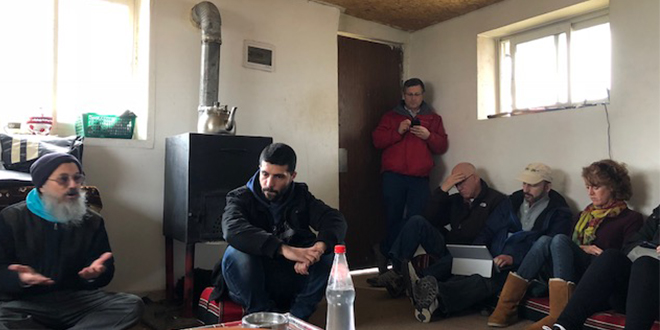
Continuing on our theme of having really awesome food, we stopped at the Gush Etzion Winery for a lovely Italian style, dairy lunch. With both non-dairy and gluten free options available for today's bloggers who are the sensitive type of the group.
After lunch we headed into Efrat, to meet with Mayor Oded Revivi. He gave us the history and geographical explanation including its future growth plans. He shared that Efrat was planned to be a city, home to 30,000 people. In the past two years alone, it has grown 60%, challenging the city to keep up with building the necessary schools and infrastructure. Efrat is surrounded by Arab farms and neighborhoods, and is very close to the Southernmost entrance to Bethlehem. Oded "…believes in building bridges not fences. When you build a fence, you don't know what is being built on the other side; when you build bridges, you know what's on the other side."
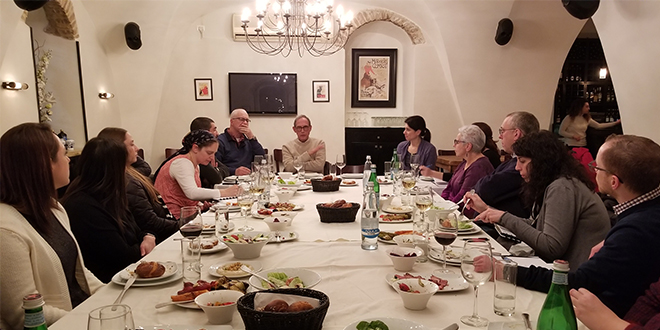
After that, we headed back to Jerusalem for some much wanted (or needed, for some) Marzipan rugelach, while some squeezed in a few minutes of shopping. We ended our day with yet another delicious dinner at La-Guta, with MK Nachman Shai. He shared with us the current perspectives on Israel / US relations following President Trump's declarations regarding Jerusalem, and Vice President Pence's visit. He also talked about the Pew study, about Israel's popularity in the US, and the challenges that the Knesset faces in terms of the relationship. Steve Hoffman joined us at La-Guta, and the group enjoyed seeing him in Jerusalem and sharing their impressions of the seminar thus far.
Throughout the day, we received an enriched understanding of what Areas "A", "B", and "C" are, and what that means to the various people in the area from a larger political perspective. The other theme we heard through the day is that we all have a responsibility for each other including caring for those who are less fortunate and living in struggling areas.
January 29, 2018
by Jessica Cohen
On our journey to fully see and experience the fabric of Israeli society, our Wolf Mission found ourselves in the Charedi (or ultra-Orthodox) part of Jerusalem. Through a carefully crafted day, we were able to learn about the community within the larger Israeli context and consider how to apply our understanding to our own work in Cleveland.
To begin our day, we heard from experts at the Jerusalem Foundation and leaders (both Charedi and not) at the Strauss campus of Hadassah College, where they seek to create culturally competent spaces of higher education for Charedim. The Jerusalem Foundation works to improve the quality of life in Jerusalem for all sectors and has done extensive demographic research on the Charedi community that drives initiatives across the city.
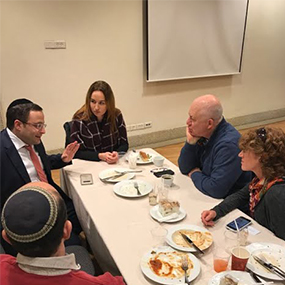
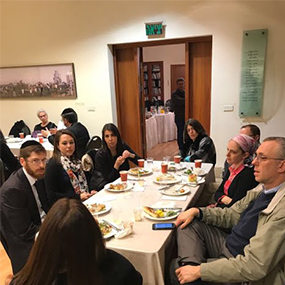
Sallai Meridor, former Israeli ambassador to the United States and former chairman of the Jewish Agency, welcomed us and gave us an overview of some of the complexities of Jerusalem. He emphasized the importance of communal change coming from within instead of being forced from without. This is particularly true with the Charedi community that holds fast to communal norms and a deep abiding faith and adherence to Jewish law.
Throughout the day we heard from members of the Charedi community who are creating access points to higher education, facilitating increased exposure and involvement in STEM education, and pioneering initiatives that serve the diverse needs of Charedim. Of particular note was the outstanding success of Hadassah College in bringing culturally competent higher education opportunities to Charedim. They have 900 Charedi students, male and female, in a variety of degree programs including biotechnology, management, optometry, speech and occupational therapy, and political science. 100% of their Charedi students are successfully placed in a career-track job following graduation. The ability of this program to provide educational access and economic opportunity to the Charedi community has been very effective.
Also during the day, we toured through Mea Shearim to see some of the community institutions and get a feel for the various sects of Charedim that call that neighborhood home.
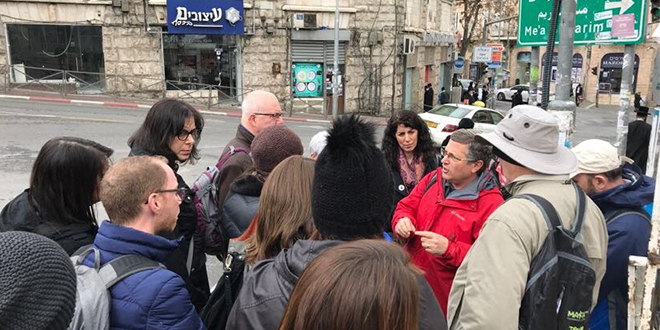
The overarching message of the morning was that despite the impression of the Charedi community to the outside world as closed, ancient, and oppositional, this is a community that is far from monolithic. In fact, it is a community deeply connected and faithful to tradition while carefully identifying and engaging in modern opportunities.
After a wonderful dairy lunch by the windmill in Jerusalem, we welcomed mentors and the director of the Youth Futures program in East Jerusalem. Funded by a Cleveland foundation, this program is changing the lives of 160 Palestinian children in East Jerusalem, using the same Youth Futures model as the rest of the country. Shadi, the director of the program lives in East Jerusalem outside the checkpoint and described how he wakes up at 4 am to cross the checkpoint before rush hour so he can be at work at the Jewish Agency on time. Despite the fact that many in their Palestinian community consider Shadi and the staff to be collaborating with Israel, they continue to do their jobs every day and prove that there is value to both Palestinians and Israelis from their success.
We closed this powerful day with a visit to the Kotel (Western Wall) and the Kotel tunnels. Ezra, our guide, gave us a meaningful look at the Temple period as we walked through the Old City and made our way underneath the Old City to the northwestern corner of the Western Wall. We then spent some time at the Kotel itself, some placing notes, some reflecting, some praying – all grateful for this amazing opportunity to immerse ourselves in Israeli society together with our colleagues and bring these lessons home to Cleveland.
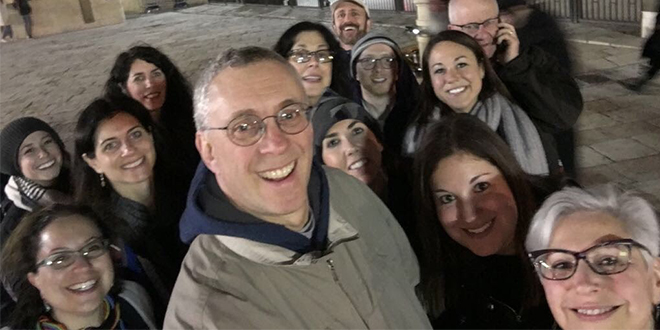
January 30, 2018
by Shelley Fishbach and Lisa Lebowitz
After full and meaningful days in Jerusalem, we packed our bags and headed to the Negev town of Yerucham. We passed a new army base and training zone that are being built in the Negev as a way to free space in central Israel and attempt to boost the areas in the Negev. There is some push-back from nature enthusiasts about using this space for training zones rather than keeping it available for hiking and other recreational activities.
Yerucham is being led by Mayor Michael Biton, an up-and-coming political and social leader. His parents were originally from Morocco and immigrated to this town where they raised Michael and his siblings. After leaving to get his education, Michael returned to the area and became involved as a professional and volunteer.
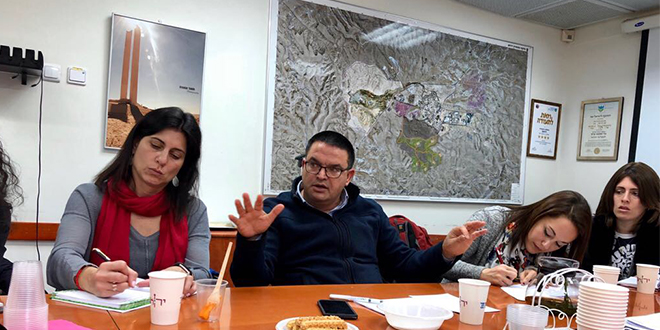
Yerucham had been neglected by the local and national government for many years and faced a large deficit. As Mayor the past seven years, he shared the elements he is trying to put in place to transform his community. His five point strategy focuses on: 1) education, 2) investing in young adults, 3) economic development, 4) narrowing gaps and welfare needs, and 5) creating a clean and green town where people have pride living. By focusing on these areas, he is hoping to keep the young people in the area while attracting new families. Many of these initiatives are possible through fundraising and partnerships. This past year, Yerucham no longer faced a deficit, and they are building their brand of “The future is in the desert.”
From Yerucham we traveled to the Bedouin township of Hura to meet with its mayor, Dr. Muhammed Al Nabari, whom Mayor Biton called the #1 mayor in Israel. The Cleveland Federation will be expanding its STEM education initiative in the Israeli periphery to include Hura in addition to Beit Shean, the Valley of Springs, and the Charedi (ultra-Orthodox) community in Jerusalem.
Mayor Al Nabari explained that the Bedouin community, once nomadic, is in a state of transition moving from a simple but stable society to a modern but unstable one. Bedouin communities have the lowest household incomes and education in all of Israel; 83% of the population is younger than 30.
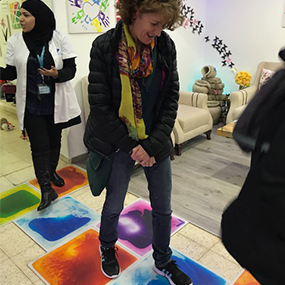
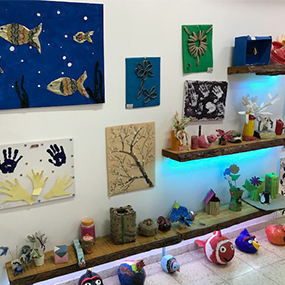
When Al Nabari became mayor in 2004, he was a pioneer in working with local leaders, in partnership with the national government, to take responsibility for improving their community's future. He improved the local schools, working outside the traditional tribal paradigm. Before he was in office, students never even saw matriculation exams, and now the area high schools are among the best in the Negev. He also increased the employment rate with a special focus on women's employment. Lastly, he founded Desert Stars, a program that develops a network of leaders from across tribes.
We next toured Hura's Al Wafa school for autistic children. Eighty-seven children aged 5-21 from Bedouin communities across the Negev attend this school where they benefit from a 1:1 student to staff ratio. In addition to cutting-edge practices for the children, the school also provides parents with needed support.
We concluded the day celebrating Tu B'Shevat (15th of Shevat), the Birthday of the Trees, with nuts and dried fruit. It was a perfect end to a day learning about how – to borrow a phrase from Isaiah's vision – the desert continues to bloom.
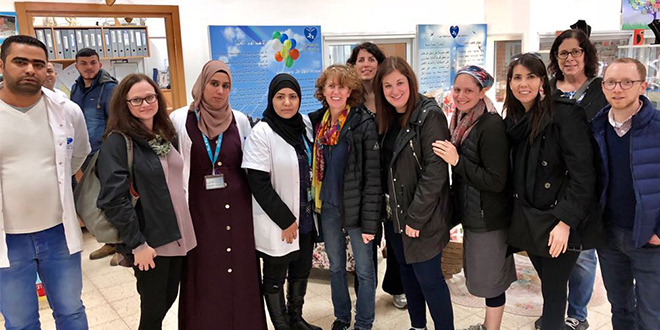
January 31, 2018
by Kelly Rubanenko
On our final day in Israel, we woke up to sunshine and a palpable feeling of group cohesiveness. We were ready to be challenged and inspired. Eilon Schwartz, Director of a think tank called Shacharit Fellows, helped us understand that the diversity in society is deep, and that different “tribes” have radically different worlds of meaning. It was suggested that less time be spent trying to convert or convince others of our beliefs, and more time spent listening, respecting, and working together with those we disagree with the most.
Next, we drove to Lod and visited Tech Career, a comprehensive program designed to help new immigrant and second generation Ethiopians enter the innovation and hi-tech arena. Executive Director Naphtali Abraham shared his harrowing tale of fleeing Ethiopia at the age of 13, spending 4 months in the jungle without food or security (or adults), arriving in a refugee camp in the Sudan, and finally being airlifted to Israel. Naphtali was educated at Yemen Orde Youth Village, served as an officer in the IDF for 21 years, and decided to enter hi-tech as the best way to help lift his community. Tech Career board member Vlad Slutzkin (who made Aliyah from Russia in the 1990’s) and Resource Development Manager Avigail Harel shared that the 550 program graduates have a 93% job placement rate and are 90% of the Ethiopians in Israeli hi-tech jobs today. Six Tech Career graduates then shared their stories, making it crystal clear how this opportunity was not just changing their lives and creating a rippling effect in their communities, but how it was changing Israeli society.
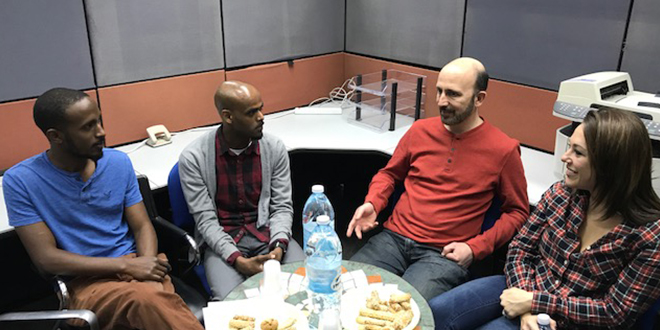
As we gathered for a Closing Dinner at Goshen restaurant, we had an opportunity to express our appreciation to guide extraordinaire, Ezra Korman, to Tami Caplan for creating a meaningful itinerary and allowing us to experience everything as a mission participant, to Oren Baratz for his strategic vision and unbelievable stories, to Steve Hoffman for his foresight and support, and to the Wolf Family for the gift of a staff development “gift” that was personally and professionally rich and meaningful.
Participants shared the following reflections:
- Anything is possible
- Don’t think, do
- Our partners are our global, Jewish family
- We saw how real leaders live
- Exposure leads to appreciation and inspiration
- We are left with a feeling of immense pride
- Change makers can be anyone and everywhere
- A camel is a horse designed by committee
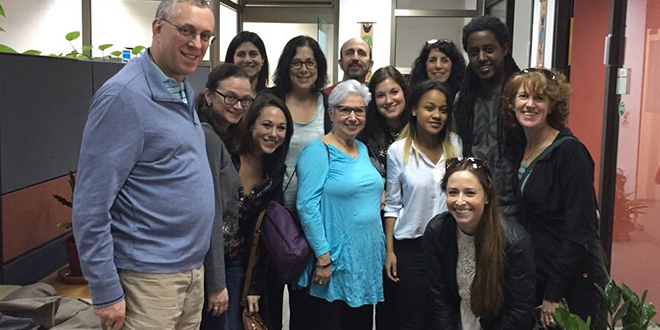


Comments